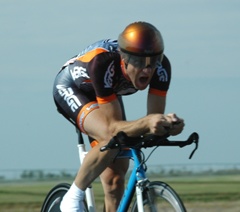
From a 2003 post to the Wattage list.
When I fit people to their bikes, I generally advocate the longest crank they can ride with correct seat height (not having to "reach" for the pedal), and still be able to maintain a fairly flat back for extended durations. I've found that fitting the legs into the"window" between the bottom of the pedal stroke and the thighs hitting the torso is what needs to be done. There are factors involved besides leg length, certainly tibia/femur relationship, foot size, hamstring flexibility, rib cage size, and pelvic angle on the bike all play a part. They play enough of a part, in my opinion, that a formula will rarely result in an optimal fit.
While I've said I "advocate the longest crank", in practice I have yet to find a rider who can "fit" anything longer than a 180. I generally wind up putting people on pretty conventional crank lengths, although shorter riders have sometimes had to look for 160's as a result.
The only time I advocate a crank length change is if I see a person whose thighs are hitting their torso, then we go down in length. I can't honestly remember ever suggesting a longer crank length. Most tall people are already on 175's, most of the problems I see are with short people on 170's (or anyone thinking they need more "leverage" on their TT bike).
This is a different fit on a road vs. TT bike too, and sometimes a person who can handle longer cranks on the road bike can't do it in a TT position, or vice-versa. For cyclo-cross or mtb, where having a flat back is not required, a slightly longer crank is often acceptable. All the same, I generally have road riders use the same crank length on their 'cross bikes.
In my own experience, I have a 91cm inseam and rode 175's until 1995, when I spent the previous Fall/Winter getting used to 180's. I took over two minutes off my 40k time that year (although I really only do at most one 40k per year on average), and became much more of a long breakaway threat than I had previously been. Around 2001, after having problems with back pain and saddle chafing that I attributed to a too-high saddle, I went back to 175's. Apparently as I became less flexible I was having a harder time making the 180's work for me with both a reasonable seat height, as well as a flat back. I've been on 175's ever since. In my case I've got a relatively "even" tibia/femur, but a slightly larger than average ribcage for a cyclist, so for me to be a bit too extended on 180's does not mean that a person of similar height won't find them comfortable with a longer inseam and smaller ribcage.
In 2004, after another painful 40k TT, I dropped down to 172.5 cranks on my TT bike. Not a huge difference from my 175's, but enough that in my fairly low TT position I get just enough extra room to still produce power, yet keep a flat back.
Putting all this in terms of power, I think, this is a situation where you might be able to discern very small improvements over a period of months, or perhaps a season. Really if you can squeeze another 2% power increase out of a 5mm longer set of cranks (due perhaps to more effective use of muscles?), then it's worth it. But beware the warning signs of running a seat too high, excessive chafing, hip pain, knee pain, and back pain are all warning signs. They are warning signs that will typically only show up when you start doing higher intensity efforts, or increased training volume , not with a few tests on a trainer.
© JBV Coaching 2006